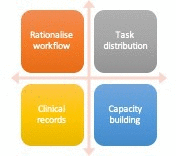Improving primary care for diabetes and hypertension: findings from implementation research in rural South India
- PMID: 33323433
- PMCID: PMC7745330
- DOI: 10.1136/bmjopen-2020-040271
Improving primary care for diabetes and hypertension: findings from implementation research in rural South India
Abstract
Background: Chronic conditions are a leading cause of death and disability worldwide. Low-income and middle-income countries such as India bear a significant proportion of this global burden. Redesigning primary care from an acute-care model to a model that facilitates chronic care is a challenge and requires interventions at multiple levels.
Objectives: In this intervention study, we aimed to strengthen primary care for diabetes and hypertension at publicly funded primary healthcare centres (PHCs) in rural South India.
Design and methods: The complexities of transforming the delivery of primary care motivated us to use a 'theory of change' approach to design, implement and evaluate the interventions. We used both quantitative and qualitative data collection methods. Data from patient records regarding processes of care, glycaemic and blood pressure control, interviews with patients, observations and field notes were used to analyse what changes occurred and why.
Interventions: We implemented the interventions for 9 months at three PHCs: (1) rationalise workflow to include essential tasks like counselling and measurement of blood pressure/blood glucose at each visit; (2) distribute clinical tasks among staff; (3) retain clinical records at the health facility and (4) capacity building of staff.
Results: We found that interventions were implemented at all three PHCs for the first 4 months but did not continue at two of the PHCs. This fadeout was most likely the result of staff transfers and a doctor's reluctance to share tasks. The availability of an additional staff member in the role of a coordinator most likely influenced the relative success of implementation at one PHC.
Conclusion: These findings draw attention to the need for building teams in primary care for managing chronic conditions. The role of a coordinator emerged as an important consideration, as did the need for a stable core of staff to provide continuity of care.
Keywords: general diabetes; organisation of health services; primary care; quality in health care.
© Author(s) (or their employer(s)) 2020. Re-use permitted under CC BY-NC. No commercial re-use. See rights and permissions. Published by BMJ.
Conflict of interest statement
Competing interests: None declared.
Figures









References
-
- GBD 2017 Causes of Death Collaborators Global, regional, and national age-sex-specific mortality for 282 causes of death in 195 countries and territories, 1980-2017: a systematic analysis for the global burden of disease study 2017. Lancet 2018;392:1736–88. 10.1016/S0140-6736(18)32203-7 - DOI - PMC - PubMed
-
- International Institute for population sciences (IIPS) and ICF. National family health survey (NFHS-4). Mumbai.
-
- European Observatory on Health Systems and Policies Series Caring for people with chronic conditions : a health system perspective. England: Mc Graw Hill, 2008. http://www.euro.who.int/__data/assets/pdf_file/0006/96468/E91878.pdf
Publication types
MeSH terms
Grants and funding
LinkOut - more resources
Full Text Sources
Medical
